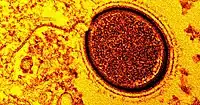Mollivirus sibericum
„Mollivirus sibericum“ (‚Sibirisches Weichvirus‘ nach lateinisch mŏllĭs [3] ‚weich‘) ist ein DNA-Virus aus dem Jungpaläolithikum, das 2015 von französischen Wissenschaftlern des CNRS im Permafrostboden Nord-Ost Russlands gefunden wurde. Mit einem Durchmesser von rund 600 nm gehört es möglicherweise zu den größten beschriebenen Viren oder virenähnlichen Organismen. „Mollivirus sibericum“ wurde 2015 in einer etwa 30.000 Jahre alten Schicht im Permafrostboden Sibiriens in etwa 30 Metern Tiefe gefunden.[4] Es gibt Hinweise auf eine entfernte Verwandtschaft mit den Phycodnaviren: Das „Mollivirus“ hat wie die Pandoraviren offenbar einen gemeinsamen Vorfahren mit den Coccolithoviren innerhalb der Familie der Phycodnaviridae,[5][6] was eine Zuordnung zu dieser Familie nahelegt.
| „Mollivirus sibericum“ | ||||||||||||||||||
|---|---|---|---|---|---|---|---|---|---|---|---|---|---|---|---|---|---|---|

„Mollivirus sibericum“ | ||||||||||||||||||
| Systematik | ||||||||||||||||||
| ||||||||||||||||||
| Taxonomische Merkmale | ||||||||||||||||||
| ||||||||||||||||||
| Wissenschaftlicher Name | ||||||||||||||||||
| „Mollivirus sibericum“ | ||||||||||||||||||
| Kurzbezeichnung | ||||||||||||||||||
| „MolliV“[2] | ||||||||||||||||||
| Links | ||||||||||||||||||
|
Genom
Das Genom von „Mollivirus sibericum“ (Isolat P1084-T) hat eine Länge von 651.523 Basenpaaren und kodiert vorhergesagt 523<1--sic!--> Proteine. Der GC-Gehalt liegt bei 60 %.[7]
Systematik
Innere Systematik
Laut CNRS (2019) gibt es neben dem ursprünglichen „Mollivirus sibericum“ inzwischen noch eine zweite Spezies „Mollivirus kamchatka“.[8]
Äußere Systematik
Schulz et al., schlugen im November 2018 im Detail folgende Systematik vor:[5][9]
| Phycodnaviridae |
| ||||||||||||||||||||||||||||||||||||||||||
Mit den Phycodnaviridae als einer vom International Committee on Taxonomy of Viruses (ICTV) anerkannten Virusfamilie bliebe für die Mollivirus-Klade anstelle einer eigenen Familie „Molliviridae“ wie gelegentlich vorgeschlagen.[11][12][13][14] allenfalls der Rang einer Unterfamilie, sollten diese Verwandtschaftsbeziehungen bestätigen: Der Sachverhalt ist derselbe wie bei den Pandora- und Coccolithoviren.
Literatur
- Dickson Kinyanyi, George Obiero, Peris W Amwayi, Stephen Mwaniki, Mark Wamalwa: In silico structural and functional prediction of African swine fever virus protein-B263R reveals features of a TATA-binding protein, in: PeerJ 6(4):e4396 (2018), doi:10.7717/peerj.4396, S. 13, insbes. Fig. 7
- Weijia Zhang, Jinglie Zhou, Taigang Liu, Yongxin Yu, Yingjie Pan, Shuling Yan, Yongjie Wang: Four novel algal virus genomes discovered from Yellowstone Lake metagenomes, in: Scientific Reports volume 5, Artikel Nr. 15131, 2015, doi:10.1038/srep15131, Abstract
- Graziele Oliveira, Bernard La Scola, Jônatas Abrahão: Giant virus vs amoeba: fight for supremacy, in: Virol J 16, 126, 4. November 2019, doi:10.1186/s12985-019-1244-3, PDF
Weblinks
- Jean-Luc Goudet: Un virus géant, Mollivirus, renaît du sol gelé après… 30.000 ans, auf: Futura Santé (futura-sciences.com), 8. September 2015 (mit bildlichen Darstellungen, französisch)
Einzelnachweise
- ICTV: ICTV Master Species List 2019.v1, New MSL including all taxa updates since the 2018b release, March 2020 (MSL #35)
- David M. Needham, Susumu Yoshizawa, Toshiaki Hosaka, Camille Poirier, Chang Jae Choi, Elisabeth Hehenberger, Nicholas A. T. Irwin, Susanne Wilken, Cheuk-Man Yung, Charles Bachy, Rika Kurihara, Yu Nakajima, Keiichi Kojima, Tomomi Kimura-Someya, Guy Leonard, Rex R. Malmstrom, Daniel R. Mende, Daniel K. Olson, Yuki Sudo, Sebastian Sudek, Thomas A. Richards, Edward F. DeLong, Patrick J. Keeling, Alyson E. Santoro, Mikako Shirouzu, Wataru Iwasaki, Alexandra Z. Worden: A distinct lineage of giant viruses brings a rhodopsin photosystem to unicellular marine predators, in: PNAS, 23. September 2019, doi:10.1073/pnas.1907517116, ISSN 0027-8424, PDF
- E. Pertsch: Langenscheidts Handwörterbuch Lateinisch-Deutsch, 7. Aufl., 1978, ISBN 3-468-07200-7; sowie PONS Online-Wörterbuch
- M. Legendre et al.: In-depth study of Mollivirus sibericum, a new 30,000-y-old giant virus infecting Acanthamoeba. Proc. Natl. Acad. Sci. U S A. (2015) 112(38): E5327-5335 PMID 26351664
- Frederik Schulz, Lauren Alteio, Danielle Goudeau, Elizabeth M. Ryan, Feiqiao B. Yu, Rex R. Malmstrom, Jeffrey Blanchard, Tanja Woyke: Hidden diversity of soil giant viruses, in: Nature Communicationsvolume 9, Article number: 4881 (2018) vom 19. November 2018, doi:10.1038/s41467-018-07335-2
- ICTV Master Species List 2018a v1, auf: ICTV - MSL including all taxa updates since the 2017 release
- David M. Needham, Alexandra Z. Worden et al.: A distinct lineage of giant viruses brings a rhodopsin photosystem to unicellular marine predators, in: PNAS, 23. September 2019, doi:10.1073/pnas.1907517116, ISSN 0027-8424, hier: Supplement 1 (xlsx)
- Centre national de la recherche scientifique: List of the main “giant” viruses known as of today (March 2019), Université Aix Marseille, März 2019.
- Die Gattungen Prymnesiovirus und Raphidovirus sind in dieser Arbeit nicht berücksichtigt, Phaeovirus ist als Phaevirus verschrieben. Mit YLPV scheinen Yellowstone Phycodnavirus YSLPV 1 bis 3 gemeint zu sein, die Schreibweise Yellow Lake Phycodnavirus (Ylpv-A, Ylpv-B) findet sich sonst nur bei Kinyanyi et al. (2018). Zur Klärung siehe Zhang et al. (2015)
- Korrigiert, siehe Phycodnaviridae §Systematik
- Centre national de la recherche scientifique: List of the main “giant” viruses known as of today, Université Aix Marseille, 18. April 2018
- Chantal Abergel: Giant viruses physiology, 24. März 2017, Laboratoire Information Génomique et Structurale (IGS), Institut de Microbiologie de la Méditerranée (IMM), Marseille, France
- Claire Bertelli, Linda Mueller, Vincent Thomas, Trestan Pillonel, Nicolas Jacquier, Gilbert Greub: Cedratvirus lausannensis – digging into Pithoviridae diversity, Environmental Microbiology (2017) 19 (10), S. 4022–4034,doi:10.1111/1462-2920.13813
- Bruno Guigliarelli, Bénédicte Burlat: PhD proposal: Structure and functional role of a new iron-sulfur protein family in giant viruses, Ecole Doctorale des Sciences Chimiques ED250, 2017